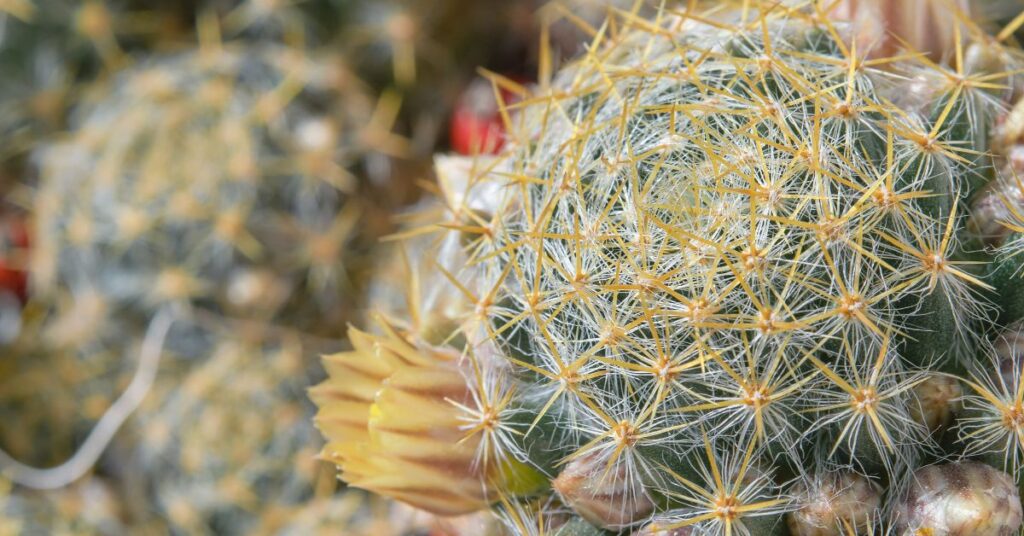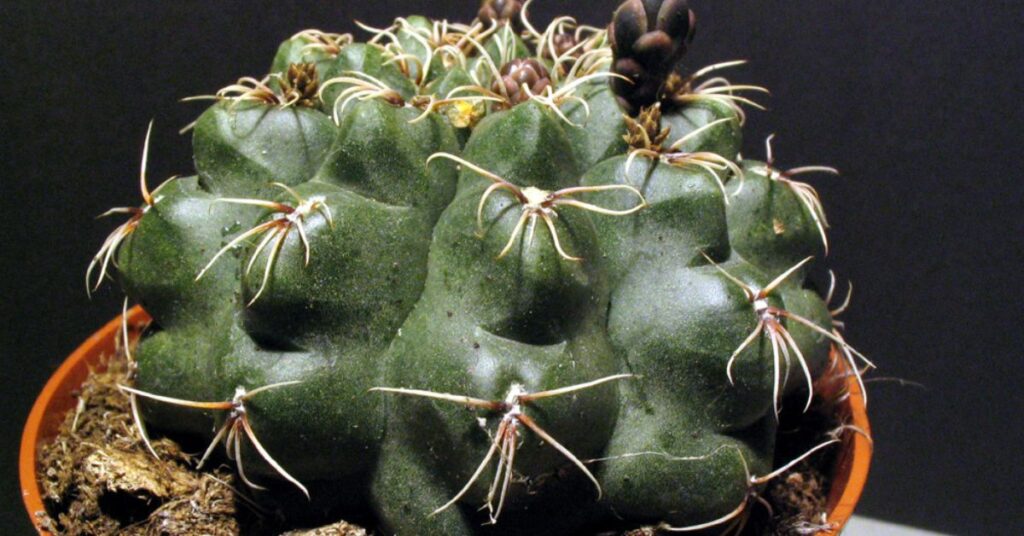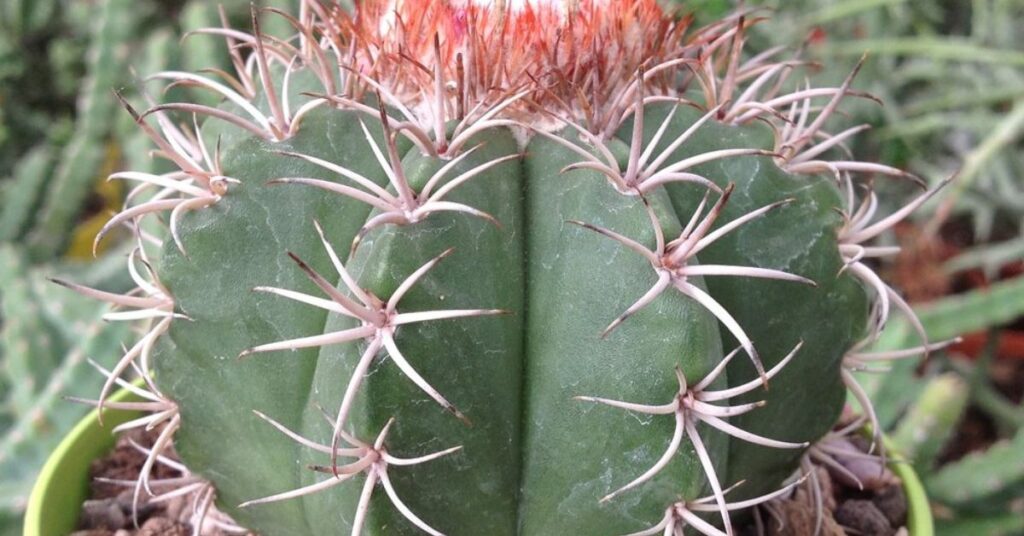In this comprehensive guide, I’m going to show you all the important information about the cactus flower plant.
You will be able to select your favorite one after reading it.
You are going to learn:
- 10 types of cactus flower plants
- Cactus flower plants indoor and outdoor
- Their common names, pictures, scientific names, followers’ colors, fruit, and pets’ safety.
- The correct way of propagation
- DIY cactus soil-making
- Care of cactus flower plant
- And
- Buying Guide
Let’s dive deep in….
Prickly Pear Cactus

Scientific Name: The scientific name of the prickly pear cactus is Opuntia.
Common Names: Some common names are tuna (fruit), sabra, sambar, nopal, nestle (fruit), and paddle cactus.
Size: It can grow up to 23 feet with a diameter of 10 feet.
Flowers: The colors of its flower can be yellow, red, or purple.
Fruit: Tuna is the fruit of prickly pear. The colors of the fruit can be green, yellow, red, and purple.
Habitat: It grows in Mexico and Caribbean islands, but you can grow it in washes, rocky hillsides, and in areas where the soil is sandy or gravelly.
Safety: Their spines are not poisonous but should not be touched with naked hands as they are very thin and small and detach from plants as touched. Avoid pets touching it.
Uses: It is an edible cactus. In the Mediterranean region and Mexico, it is eaten as salad and with other dishes. You can fry it and make cactus water or cactus juice.
It is antioxidant and used for treating diabetes, high cholesterol, obesity, and hangovers.
Easter lily cactus

Scientific Name: The scientific name of the easter lily cactus is Echinopsis.
Common Names: Common names of this plant are hedgehog cactus and sea-urchin cactus.
Size: This cactus may reach 2 feet in width and 1 foot in length.
Flowers: This plant blooms large white or pink flowers and looks very beautiful.
Flowers grow on long, wooly stems.
Fruit: Fruits of easter cactus are green in color and bloom in spring near Easter.
This is the reason for giving the name so.
Habitat: It is native to Brazil and Argentina. Lowland environments up to 1000 meters above sea level are adaptable for it. The climate should be tropical and continental.
Safety: The TOXIC plant has alkaloids that are harmful to humans and pets. It can cause dizziness and stomach pain even if eaten in a small amount.
Uses: Easter lily cactus is mostly used for decoration. It is a houseplant and can be used in gardens, along pathways, etc.
Crown cactus

Scientific Name: The scientific name of the crown cactus is Rebutia perplexa.
Common Names: The common names are Aylostera perplexa (Donald) Mosti & Papini and Rebutia perplexa Donald.
Size: The height of the crown cactus can be 4 inches, and the stem diameter can be 2.5 feet. When the plant matures, grow clumps that can be 4 to 6 inches wide.
Flowers: The Rebutia produces orange or gold flowers in the spring season and in summer as well. The way the flowers bloom is different from other cacti. They grow at the base of plants and also at stems.
Fruit: The fruit’s color is red. It is edible, but don’t eat it until confirmed by experts.
Habitat: Crown cactus mostly grows in high elevations in South America. Northern Bolivia and Northern Argentina are common places to grow.
Safety: The fruit of this plant is edible. The spines are small in size and safe to touch, but holding them tightly can hurt.
Uses: It can be used in three ways. For eating, and decorating the room, and may be used in medicines.
Orchid Cactus

Scientific Name: Epiphyllum is the scientific name of the orchid cactus.
Common Names: Climbing cactus, Orchid cactus, and Leaf cactus are common names of Epiphyllum.
Size: The height of the leaf cactus can be 1 to 12 inches. This plant can live many years if cared for properly.
Flowers: They have different colors, like white, red, pink, yellow, and orange. Their diameter can be 20 centimeters.
Fruit: The 3 to 4 cm long fruit is edible. It also has different colors. The fruit is similar to the pitaya fruit.
Habitat: Orchid cactus is native to Central America and South America. It is difficult for this plant to survive below 10 °C.
Safety: This type of cactus is non-toxic to humans. It is also safe for pets.
Uses:Like other cacti, you can use it to decorate your room. It is used for medication. It is especially used for treating cardiac affections.
Night-blooming cereus

Scientific Name: The scientific name of the night-blooming cereus is Selenicereus.
Common Names: Night-blooming cereus, Queen of the Night, Princess of the Night, and Lady of the Night are common names.
Size: A few feet to several meters, it can grow. Each type mentioned here has many species. That’s why the color of flowers, fruit, and size changes.
Flowers: This plant has large flowers with white color. These flowers have a good fragrance. They bloom for a single. Moths are attracted due to their fragrance.
Fruit: Small fruits of night-blooming cereus are edible. Fruit is a mildly sweet berry.
Habitat: It is native to tropical and subtropical regions. It is found in Central America, South America, and the Caribbean.
Safety: Selenicereus is safe for humans and pets. Some people may be allergic to its flowers and fruit.
Uses: It is cultivated as an ornamental plant. People have been using it in traditional medicines. It can be used in culinary applications.
Star Cactus

Scientific Name: The Scientific name of the star cactus is Astrophytum.
Common Names: Bishop’s cap cactus, sea urchin cactus, and sand dollar cactus are common star cactus.
Size: This plant reaches 6 to 12 inches in height. The width of the cactus can be 6 inches.
Flowers: Start cactus produces star-shaped flowers. These flowers can be yellow, cream, or white.
Fruit: Fruits are small and have seeds that can be the source of propagating new plants. Green and pink are common colors of fruit.
Habitat: Astrophytum is native to some parts of southwestern Texas and Mexico. They adapt to dry, rocky environments for growth.
Safety: This is a toxic plant, and do not touch it without gloves, as spines can cause irritation.
Uses: This ornamental plant can be grown indoors and is popular due to its unique appearance. It has some uses in traditional medicines. Some species of star cactus are listed as endangered.
Woolly nipple cactus

Scientific Name: The scientific name of the woolly nipple cactus is Mammillaria Bombycina.
Common Names: Woolly nipple cactus, silken pincushion, or simply the woolly cactus are the common names of this cactus.
Size: This cactus grows 3 to 6 inches in height and spreads to a width of about 3 to 6 inches.
Flowers: Small, dainty flowers that are pink or lavender are produced on this cactus. These occur in spring or early summer.
Fruit: Small spherical fruit that develops after successful pollination of the flowers. Seeds contribute to the reproduction of woolly cactus.
Habitat: Central Mexico is the main area of natural growth of Mammillaria bombycina. Arid and semi-arid environments are adaptable to it.
Safety: It is not toxic, but its spines can cause irritation or injury if handled improperly.
Uses: Like many cactus species, conservation efforts may be necessary due to threats. The main use of woolly cactus is for indoor decoration.
Chin Cactus

Scientific Name: The scientific name of the chin cactus is Gymnocalycium.
Common Names: Spider-Cactus, Green Tomato Cactus, and Moon Cactus are common names for chin cactus.
Size: Chin cactus can reach a height of 10 to 15 cm and a diameter of 30 cm.
Flowers: Pinkish rose flowers up to 5 cm long bloom in spring on the older areoles on the side part of the stem.
Fruit: Dark bluish-purple fruits up to 2 cm long are produced.
Habitat: Grasslands or rocky ground in South American countries, most notably Argentina and Bolivia, and also Brazil, Paraguay, and Uruguay are the main regions of its growth.
Safety: This plant is safe for human interactions, but abdomen aches can result in injection.
Uses: This plant is only used for cultivation purposes, especially in mutated form.
Christmas Cactus

Scientific Name: The scientific name of the Christmas cactus is Schlumbergera spp.
Common Names: Holiday cactus or Thanksgiving cactus are the common names of Christmas cactus.
Size: It is a moderate-sized houseplant. The size of mature plants ranges from 12 to 24 inches.
Flowers: Flowers bloom at the tips of their stems. Red, pink, purple, or white shades they have.
Fruit: Holiday cactus produces berry-like fruits after successful pollination.
Habitat: Thanksgiving cactus is native to the cloud forests of Brazil, where they grow as epiphytes on trees. This plant thrives in the cool, shady, and humid conditions.
Safety: Christmas cactus is generally safe and non-toxic to humans and pets.
Uses: The most prominent use of Christmas cacti is as gift-giving.
Dwarf Turks Cap Cactus

Scientific Name: Melocactus matanzanus
Common Names: Dwarf Turk’s Cap Cactus, Turk’s Cap Cactus, Melon Cactus
Size: 4 inches height, 4 inches spread
Flowers: Pink
Fruit: Pink
Habitat: Northern Cuba’s Matanzas and Las Villas provinces
Safety: Fruits are edible, but spines can hurt
Uses: Ornamental plant
Rat Tail Cactus
Scientific name: Disocactus flagelliformis
Common name: Rattail cactus
Size: 6 feet long
Flowers: Hot pink flowers
Fruit: No fruit
Habitat: Southwestern Mexico and Central America
Safety: Not poisonous, but some parts of the plant can cause irritation
Uses: Filter out the air and transfer it into a clean, fresh environment
Mammillaria sheldonii
Scientific name: Mammillaria sheldonii (Britton & Rose)
Common name: Sheldon’s Pincushion
Size: The height of the plant can grow to 20 centimeters and 6 centimeters in diameter.
Flowers: Funnel-shaped pink flowers and light purple
Fruit: The fruit of this plant is edible
Habitat: Mainly found in Mexico, grows on gravelly sops, hillsides, and plains
Safety: Plant is safe for humans and pets
Uses: Edible fruits, ornamental plants, chemical defenses
Echinocereus
Scientific name: Echinocereus reichenbachii
Common name: Lace hedgehog cactus, Kingcup cactus
Size: 8 inches tall and 3 inches wider
Flowers: Purple and rose pink
Fruit: Small, round berry-like, and edible
Habitat: Chihuahuas dessert, in some parts of northern Mexico and southern United States
Safety: Safe for humans and pets
Uses: work as a natural air purifier
Bunny Ears Cactus
Scientific name: Opuntia microdasys
Common name: Bunny ears cactus, Angel’s-wings, Polka-dot cactus
Size: The plant can grow up to 2 to 3 feet tall and 4 to 6 feet wide
Flowers: Small 1 to 3 inches yellow flowers
Fruit: not edible
Habitat: Central and northern Mexico
Safety: Nontoxic to humans and pets
Uses: Ornamental plant, border plant
Blue Flame Cactus
Scientific name: Pilosocereus azureus
Common name: Blue candle cactus, Blue myrtle cactus
Size: This plant can grow up to 10 meters tall
Flowers: White flowers
Fruit: The fruits are often referred to as garambullos and are edible
Habitat: This plant is a native of central and northern Mexico
Safety: The plants are safe for humans and pets, but their sharp spines can cause some
damage
Uses: edible fruit, ornamental value, commercial use
Parodia Magnifica
Scientific: Name Parodia magnifica
Common: Name balloon cactus
Size: 3 to 6 inches tall and 18 inches broad
Flowers: Yellow funnel-shaped flowers
Fruit: The fruit of this plant is edible
Habitat: Southern Brazil, Argentina
Safety: Safe for humans and pets, but watch out for spines
Uses: Ornamental plant
Disocactus Ackermannii
Scientific name: Disocactus ackermannii
Common name: red orchid cactus
Size: 20 centimeters long, 4 feet wide
Flowers: red funnel-shaped flowers
Fruit: Pineapple, bananas, and strawberries taste like
Habitat: Veracruz and Oaxaca, Mexico
Safety: safe for humans but can cause irritation to pets
Uses: Ornamental plant, edible fruit
Moon Cactus
Scientific name: Gymnocalycium mihanovichii
Common name: Ruby Ball, Red Cap, Red Hibotan, or Hibotan cacti
Size: 30.5 centimeters
Flowers: White, pink, orange and red
Fruit: Has hairs and spins and is edible with a sweet flavor
Habitat: South America’s deserts in Brazil, Argentina, and Paraguay
Safety: The plant is safe for humans and animals, but watch for spines
Uses: Ornamental plant
Totem Pole Cactus
Scientific name: Pachycereus Schottii
Common name: Monumental poles
Size: This plant can grow up to 20 to 40 feet tall.
Flowers: This plant produces light pink flowers that open up by dusk and close by mid-morning
Fruit: This plant produces the egg-shaped edible fruit in red color with pulp
Habitat: This plant is native to the Pacific Northwest. The area includes modern-day Oregon, Columbia, and British Colombia
Safety: The plant is safe for both humans and animals
Uses: Welcome sign, memorial, tomb
Old Lady Cactus
Scientific name: Mammillaria hahniana
Common name: Peruvian Wooly Cactus
Size: The size of the plant is 3.5 inches tall and the same diameter
Flowers: Hot pink
Fruit: The fruits of this plant are edible
Habitat: The plant grows in Mexican desserts
Safety: The plant is safe for both humans and pets
Uses: Ornamental plant, educational purpose
Propagation of Cactus flower plant
Propagation of cacti is very easy. Most species of cacti can be propagated with stem cutting.
Cut the stem of the cactus with a length of 5 to 7 inches and apply fungicide on the cut side. Leave it on dry paper for drying for a few days.
Make cactus soil with three parts of all-purpose potting soil, two parts sand, and one part perlite. You can buy it online as well.
Add it to a clay pot and plant the cactus with a depth of up to half to one inch or according to cactus soil. Keep it in sunlight but not intense light. Water it after one week.
Repotting is simple. Just select a bigger pot, but not so big. Fill it with cactus soil and plant the cactus. You can give the water if needed.
Care of Cactus flower plant

The special thing about cacti is they don’t need much care. They belong to succulent plants and do not need much water.
Avoid over-watering. Solid must allow drainage. Don’t keep it in intense light for more than 5 hours.
Give fertilizers only once in a whole year or once in two months. It should contain nitrogen, phosphorus, and potassium. Their ratio should be 5-10-10.
Buying Guide
The best place to buy any type of cactus plant is a nursery, but if you prefer buying online, Amazon and Estay are the best places.
Before buying, check reviews, ratings, most sold, and price comparisons.
Here you have it.
Cactus flower plant with its many types, the correct way of propagation, brief care, and buying guide.
Now, I want to hear from your side.
What type of cactus are you going to buy?
Do you prefer DIY soil or pre-make cactus soil?
Let me know in the comment section.
